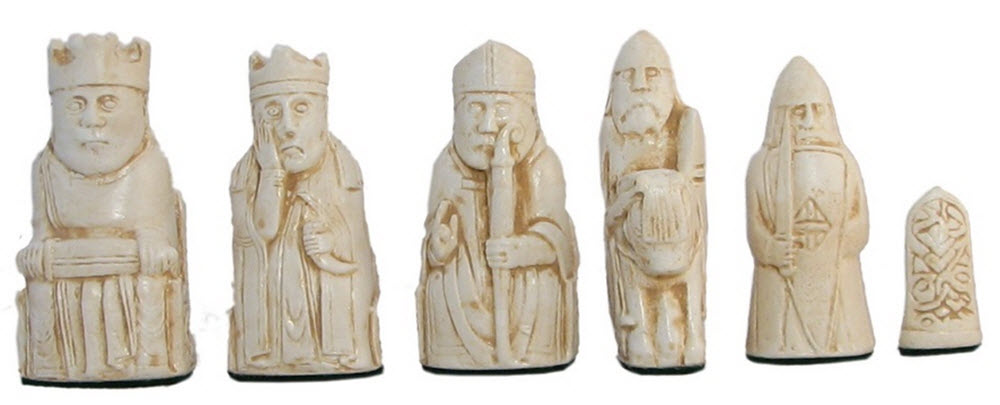Contents
In 1831, pieces from 12th-century chess sets were found on the island Lewis in the Outer Hebrides of Scotland. They were found alongside other game pieces. The chess and other game pieces in the hoard are made from carved walrus ivory, except three pieces which are made from whale tooth.

The hoard found in 1831 consisted of 93 artefacts:
- 78 chess pieces
- 14 round tablemen for the game of tables (plain ivory discs)
- 1 buckle made from walrus ivory. It is possible that this buckle was a part of the bag holding the hoard.
Four major pieces, and many pawns, are still missing from the chess sets.
A newly identified ”warder” piece (castle or rook) was sold for £750,000 in 2019.
Where are they today?
The 93 artefacts in the hoard were divided and sold in the 1800s.
Today, 82 of the 93 artefacts are at the British Museum in London, while 11 are at the National Museum of Scotland in Edinburg.
The British Museum paid 80 guineas for the 82 pieces, after being misled to believe it was the entire hoard.
Origin
According to the British Museum, the chess pieces were probably carved in Trondheim, Norway. Back in the 12th century, that was the capital of Norway, and the Outer Hebrides – and several other Scottish islands – were ruled by Norwegian rulers.
Condition
The chess pieces do not show signs of wear associated with actually being played with. Therefore, some researchers have suggested that they were the stock of a trader, and were hidden after some mishap.
None of the pieces show any signs of colouring today, but in 1832 some of the pieces were described as being red.
The chess pieces
The hoard contained the following types of chess pieces:
– Kings
– Queens
– Bishops
– Knights
– Warders
– Pawns
The kings and queens are seated on thrones. The kings wear a long mantle and each have a crown with four trefoils. All the kings except one have long braided hair. All kings hold a sheathed sword, which is resting over the knees.
The queens are cupping their chin in their right hand. All have long hair in braids, covered with a veil. Some wear crowns that look the same as the king´s, while others have a continuous pierced band. All queens wear a gown, together with a long mantle or cloak.
The bishops are very variable in their design, but all are clean-shaven, have shoulder-length hair and wear a mitre. All are holding a crozier, and some are also holding a book. Interestingly, some bishops stand up while others are seated. Five of the bishops wear a cope over a tunicle, while the others wear pontifical vestments, including a chasuble and stole.
All the knights are mounted on horses and carry spears and long shields. They have both beards and moustaches. Only some of the have swords, and those that do carry their sword hung from a baldric.
The warders are standing up, carry shields and have their swords drawn. The have long straight hair and helmets. Notably, four of the warders are biting their shields. Most of the warders wear long gambesons, but some have chain mail instead.
The pawns do not look like humans; they are just bullets or slabs. Two of them feature engraved ornamentation.
